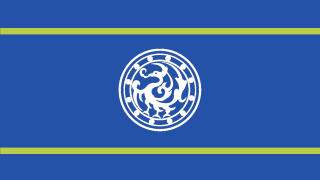Cheonghae
Cheonghae Federation 청해 연방 | |
|---|---|
|
Flag | |
Motto: Beautiful golden sky, planets, and milky way 아름다운 금수강산 | |
| Capital | Hanoul |
| Largest city | Hanoul, Planet Han-Gyeong |
| Official languages | Korean |
| Recognised national languages | Korean |
| Ethnic groups (2023) | Hannese (85%) Others (15%) |
| Demonym(s) | Hannese(s) |
| Government | Federal Republic |
• President | Shin Soo-Yeon |
| Legislature | National Assembly |
| Population | |
• 2136 estimate | 19.5 trillion |
• 2136 census | 19,500,000,000,000 |
| HDI (2136) | 0.956 very high |
| Currency | Won(₩) |
| Date format | mm-dd-yyyy |
Cheonghae Federation, natively 청해 연방 - is a democratic country located in the spiral arm of our galaxy. 396 planets belong to the Federation, of which 340 are habitable planets.
Cheonghae was founded by the crew and passengers of the colony ship 'Eulji', which departed from South Korea in 2060. Cheonghae reorganized the country's political system from a single republic to a federation in 2101 and revised its constitution.
History
Goverment
The structure of Cheonghae's government is determined by its constitution. Cheonghae's constitution has been revised several times since its enactment in 2072, and today's constitution has been revised in 2101.
Like many democratic countries, Cheonghae's government is composed of a legislative, judicial, and executive branch. The chief executive officer of the administration is the president, who also serves as the head of state. As the head of the administration, the president has executive, military, and diplomatic powers. The president can be impeached if he violates the Constitution, which requires the consent of a majority of the National Assembly and a final ruling by the Supreme Court. The legislature consists of a unicameral system National Assembly. The National Assembly consists of 1,500 members, who have the power to draft, amend, and enact legislation and the power to revise the Constitution. The Assembly can be dissolved by the president's decision, but in this case, a final ruling from the Supreme Court is required. The judiciary consists of the district court, the high court, and the Supreme Court. The district court and the high court are scattered in each province, but there is only one Supreme Court. The Supreme Court consists of Supreme Court justices recommended by the president and the National Assembly, and the elected chief justice.
Society
Largest cities or towns in Cheonghae
Taken from Cheonghae Census 2136 | |||||||||
|---|---|---|---|---|---|---|---|---|---|
| Rank | Planet | Pop. | |||||||
 Hanoul  Bu-Gyeong |
1 | Hanoul | Han-Gyeong | 59,563,200 |  Mirinae  Yulseong | ||||
| 2 | Bu-Gyeong | Han-Gyeong | 55,242,350 | ||||||
| 3 | Mirinae | Han-Gyeong | 43,235,380 | ||||||
| 4 | Yulseong | Cheong-Seong | 42,532,450 | ||||||
| 5 | Dadaepo | Han-Gyeong | 42,375,770 | ||||||
| 6 | Garam | Saegaram | 42,145,530 | ||||||
| 7 | Saeju | Hanju | 37,894,600 | ||||||
| 8 | Hyeonju | Yulpyeong | 32,583,700 | ||||||
| 9 | Han-Ryeon | Baekhan | 31,396,300 | ||||||
| 10 | Beaksan | Beakhan | 31,254,300 | ||||||
Foreign Relations
Military
Economy
Cheonghae's economy is led by heavy industry, high-tech, and petrochemical industries. The majority of large corporations set high-tech, petrochemical, and heavy industries as their main business areas, and Cheonghae's exports through these industries account for 50% of Cheonghae's total GDP. Cheonghae is also self-sufficient in most of the components and base materials needed for heavy and high-tech industries. Microchips and major mechanical components are one of Cheonghae's flagship products. However, Cheonghae is not self-sufficient in rare earths and imports them from abroad.
Raw materials such as food, light industrial consumer goods, and oil are Cheonghae's major import items. Although food such as seafood is produced in the country, Cheonghae's food self-sufficiency rate is less than 40%, and Cheonghae relies on imports for a significant portion of its food. Also, because the amount of oil produced in Cheonghae is minimal, Cheonghae relies on foreign oil-producing countries for its oil.
Cheonghae generates electricity needed in the country through nuclear power and fossil fuel generation. Nuclear power accounts for 50% of Cheonghae's electricity generation, and fossil fuel power accounts for 40% of Cheonghae's electricity generation. However, fossil fuel generation has been criticized for triggering air pollution, and it has been pointed out that it may act as a major risk for the country because it has to rely on foreign countries for a large portion of its raw materials. Because of this, Cheonghae is increasing its share of renewable energy such as solar and wind power. Renewable energy currently accounts for less than 10% of Cheonghae's electricity generation, but it is predicted that the share will increase to 30% by the 2030s.
